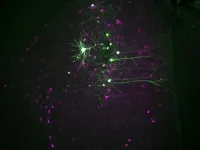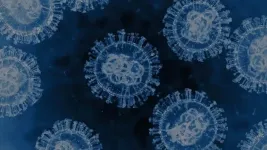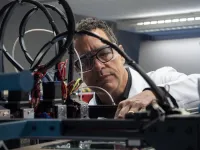(Press-News.org) Gene therapy can effectively treat various diseases, but for some debilitating conditions like muscular dystrophies there is a big problem: size. The genes that are dysfunctional in muscular dystrophies are often extremely large, and current delivery methods can’t courier such substantial genetic loads into the body. A new technology, dubbed “StitchR,” surmounts this obstacle by delivering two halves of a gene separately; once in a cell, both DNA segments generate messenger RNAs (mRNAs) that join seamlessly together to restore expression of a protein that is missing or inactive in disease.
Published in the journal Science, StitchR—short for “stitch RNA”—restored expression of large therapeutic muscle proteins to normal levels in two different animal models of muscular dystrophy. StitchR enabled expression of the protein Dysferlin, which is lacking in individuals with limb girdle muscular dystrophy type 2B/R2, as well as the protein Dystrophin, which is absent in patients with Duchenne muscular dystrophy.
Duchenne muscular dystrophy is the most common early onset form of muscular dystrophy; many boys become wheelchair bound in their teens and die in their twenties. People with limb girdle muscular dystrophy experience weakness and wasting in the shoulder, hip, and thigh muscles, and often have difficulty standing, moving, and doing everyday tasks.
“Gene therapy is a powerful tool for delivering a healthy gene copy back to a patient’s cells to correct genetic diseases, but the vectors used to deliver this information are small, which has so far precluded their use for treating a whole host of diseases caused by mutations in large genes,” said Douglas M. Anderson, PhD, lead study author and assistant professor of Medicine in the Aab Cardiovascular Research Institute at the University of Rochester School of Medicine and Dentistry (SMD). “Instead of delivering the full gene in a single vector, which isn’t possible, we’ve developed an efficient dual vector system where two halves of a gene are delivered separately but come together to reconstitute the large mRNA in the affected tissues.”
The technology first arose from a serendipitous observation made in the lab several years ago, that when two separate mRNAs were cut by small RNA sequences called ribozymes, they became seamlessly ligated (joined) and translated into full-length protein. The team found that when ribozymes cleave or cut RNA, they leave ends that are recognized by a natural repair pathway.
“Similar to when CRISPR enzymes are used to cut DNA, the CRISPR enzymes are just the scissors, and it’s a cell’s natural repair enzymes that glue the DNA back together,” noted Anderson, who is also a member of the University of Rochester Center for RNA Biology. “We think something similar is happening here, but for RNA. The ribozymes are acting as the scissors and the cell’s natural repair pathways are able to join the two RNAs back together. It’s remarkable that two separate mRNAs are able to find themselves and that the process can be so efficient.”
The lab optimized efficiency of the process (over 900-fold from their initial experiments) and adapted the technology into a powerful gene delivery mechanism. When two halves of a large therapeutic gene are encoded into adeno-associated virus (AAV) vectors, which are the most commonly used vectors for gene therapy because they are safe and don’t cause disease in humans, the ribozymes cut the ends of the mRNAs and they subsequently join, forming a single, seamless mRNA capable of producing protein in a desired tissue.
The research team, including co-first author Sean Lindley, who recently received his PhD from the Anderson lab, found that the stitched mRNAs appear to behave essentially the same way as their natural full-length counterparts, effectively translating genetic information into functional proteins.
Self-cleaving ribozymes, which are essential for StitchR activity, are found naturally throughout the animal kingdom and are comprised of different families, which exhibit different cleavage activities. After testing numerous ribozyme families and sequences, they ultimately identified a formula that led to a high level of protein production and approached the levels achieved by genes expressed from just a single vector.
“Doug is extremely creative and detail oriented, and the fact that he’s worked out how two different pieces of mRNA can find one another in a cell and be joined seamlessly to create a functional mRNA is really exciting,” said Lynne E. Maquat, PhD, director of the UR Center for RNA Biology. “The concept sounds simple, but this required considerable bench work to optimize the molecules involved, ensure they are stable in cells, and make the process as efficient as possible.”
According to Anderson, StitchR can be coupled with many different types of vectors that are used to deliver or express a gene in cells and that it appears to work efficiently with any mRNA sequence, opening the door for its use in a wide range of diseases and applications. “StitchR is really plug and play at this point. The sequence requirements for StitchR are minimal, and we’ve now tested this with many different genes and sequences,” he said.
Another feature of this technology is that only the full-length protein is produced.
“Other dual vector approaches have been in development for decades but have been plagued by lack of efficiency and the production of less than full-length products. Because StitchR occurs at the level of RNA, we can control and ensure that only the full-length protein product gets made. This differentiates StitchR from other dual vector technologies, for example inteins, a protein-ligation technology, which can be efficient but requires the expression of smaller protein fragments that may have unknown effects in a cell,” added Anderson.
“It’s been a long but fulfilling process to go from an initial research observation to a therapeutic application, but that’s always been a major goal of our lab, and I think the promise of basic research. With StitchR and other tools we are working towards treatments for some of the most debilitating genetic diseases on the planet, many of which have no current treatments or cures,” said Anderson.
The lab is now in the process of forming collaborations with other research labs and generating StitchR vectors to treat numerous diseases caused by large genes, of which there are thousands.
In addition to Anderson and Lindley, SMD staff scientists Kadiam C. Venkata Subbaiah (co-first author), Pornthida Poosala, FNU Priyanka and technicians William Richardson and Tamlyn Thomas contributed to the work, as well as CANbridge Pharmaceuticals scientists Yijie Ma, Leila Jalinous, and Jason A. West. The work was funded by the University of Rochester, Jain Foundation, CANbridge Phamaceuticals, and Scriptr Global, Inc. Anderson is a co-founder of Scriptr Global, Inc. and holds several US and foreign patent applications for his research related to StitchR and other RNA-based technologies. Scriptr licensed the StitchR technology from the University of Rochester.
END
New discovery enables gene therapy for muscular dystrophies, other disorders
RNA-based technology facilitates effective use of gene therapy for difficult-to-treat, large-gene diseases
2024-11-14
ELSE PRESS RELEASES FROM THIS DATE:
Anti-anxiety and hallucination-like effects of psychedelics mediated by distinct neural circuits
2024-11-14
New research suggests that it could be possible to separate treatment from hallucinations when developing new drugs based on psychedelics. The anti-anxiety andhallucination-inducing qualities of psychedelic drugs work through different neural circuits, according to research using a mouse model. The work is published Nov. 15 in Science.
The research shows that decoupling the beneficial effects of psychedelics from their hallucinogenic effects isn’t just a matter of chemical compound design. It’s a matter of targeted neural circuitry.
“In the past, we did this using chemistry by making new compounds, but here we focused on identifying the circuits responsible ...
How do microbiomes influence the study of life?
2024-11-14
UNIVERSITY PARK, Pa. — Microorganisms — bacteria, viruses and other tiny life forms — may drive biological variation in visible life as much, if not more, than genetic mutations, creating new lineages and even new species of animals and plants, according to Seth Bordenstein, director of Penn State’s One Health Microbiome Center, professor of biology and entomology, and the Dorothy Foehr Huck and J. Lloyd Huck Endowed Chair in Microbiome Sciences. Bordenstein and 21 other scientists from around the world published a paper in the leading journal Science, summarizing research that they said drives a deeper understanding of biological ...
Plant roots change their growth pattern during ‘puberty’
2024-11-14
Ghent, November 15, 2024 – Understanding how roots grow can help us develop plants that, for example, are more resistant to drought. Research by Prof. Bert De Rybel’s team (VIB-UGent), in collaboration with the VIB Screening Core and Ghent University, uncovers how roots go through a puberty phase, which could have important implications for developing climate-resilient agriculture. Their work appears in Science.
Plant puberty
Plants, like all living organisms, transition through various developmental stages, starting as a seed, becoming a shoot, and eventually a full-grown, fertile plant. They even go through a sort of ‘puberty’ ...
Study outlines key role of national and EU policy to control emissions from German hydrogen economy
2024-11-14
Hydrogen is set to play an important role in a future low-carbon economy. However, the hydrogen value chain comes with a set of emissions challenges that need to be addressed for hydrogen deployment to help achieve climate goals. A study prepared by the Research Institute for Sustainability – Helmholtz Centre Potsdam (RIFS) with support from Environmental Defense Fund Europe evaluates the potential impact of climate-warming emissions in Germany’s future hydrogen economy and provides recommendations for German and EU policymakers on how to avoid them.
There are hopes that hydrogen can become a carbon neutral alternative to fossil ...
Beloved Disney classics convey an idealized image of fatherhood
2024-11-14
For decades, Disney animations have shaped perceptions of family relationships and gender roles. Although much focus has traditionally been on princesses and female characters, a new study shifts attention to fatherhood and the evolving ideals of masculinity.
"In the history of Disney films, female characters and princess imagery have been widely analyzed, yet the role of masculinity has been explored far less. My research aims to deepen our understanding of the male ideals Disney has constructed and how they reflect ...
Sensitive ceramics for soft robotics
2024-11-14
Most people think of coffee cups, bathroom tiles or flower pots when they hear the word "ceramic". Not so Frank Clemens. For the research group leader in Empa's Laboratory for High-Performance Ceramics, ceramics can conduct electricity, be intelligent, and even feel. Together with his team, Clemens is developing soft sensor materials based on ceramics. Such sensors can "feel" temperature, strain, pressure or humidity, for instance, which makes them interesting for use in medicine, but also in the field of soft robotics.
Soft ceramics – how is that supposed to work? Materials ...
Trends in hospitalizations and liver transplants associated with alcohol-induced liver disease
2024-11-14
About The Study: This study found significant rate increases for alcohol-induced liver disease-related hospitalizations and liver transplants across sex and age groups between 2005 and 2021. Although older males had the highest absolute increases, the greatest relative increases occurred in younger individuals, particularly females.
Corresponding Author: To contact the corresponding author, Michele Molinari, MD, MSc, email molinarim@upmc.edu.
To access the embargoed study: Visit our For The Media website at this link ...
Spinal cord stimulation vs medical management for chronic back and leg pain
2024-11-14
About The Study: This systematic review and network meta-analysis found that spinal cord stimulation therapies for treatment of chronic pain in back and/or lower extremities were associated with greater improvements in pain compared with conventional medical management. These findings highlight the potential of spinal cord stimulation therapies as an effective and valuable option in chronic pain management.
Corresponding Author: To contact the corresponding author, Konstantinos Soulanis, M.Sc., email konstantinos.soulanis@iqvia.com.
To access ...
Engineered receptors help the immune system home in on cancer
2024-11-14
Most cancer treatments – from chemotherapies to engineered immune cells – have a host of side effects, in large part because they affect healthy cells in the body at the same time as targeting tumor cells. For the same reason, designing new cancer drugs can be challenging due to the molecular similarities between tumor cells and healthy cells.
Now, UC San Francisco researchers have designed highly customizable biological sensors which can ensure that engineered cells are only activated in certain environments – such as the vicinity of a tumor. This could yield cancer therapies ...
How conflicting memories of sex and starvation compete to drive behavior
2024-11-14
Two conflicting memories can both be activated in a worm’s brain, even if only one memory actively drives the animal’s behaviour, finds a new study by UCL researchers.
In the paper published in Current Biology, the researchers showed how an animal’s sex drive can at times outweigh the need to eat when determining behaviour, as they investigated what happens when a worm smells an odour that has been linked to both good experiences (mating) and bad experiences (starvation).
The scientists were seeking ...
LAST 30 PRESS RELEASES:
Sleeping in on weekends may help boost teens’ mental health
Study: Teens use cellphones for an hour a day at school
After more than two years of war, Palestinian children are hungry, denied education and “like the living dead”
The untold story of life with Prader-Willi syndrome - according to the siblings who live it
How the parasite that ‘gave up sex’ found more hosts – and why its victory won’t last
When is it time to jump? The boiling frog problem of AI use in physics education
Twitter data reveals partisan divide in understanding why pollen season's getting worse
AI is quick but risky for updating old software
Revolutionizing biosecurity: new multi-omics framework to transform invasive species management
From ancient herb to modern medicine: new review unveils the multi-targeted healing potential of Borago officinalis
Building a global scientific community: Biological Diversity Journal announces dual recruitment of Editorial Board and Youth Editorial Board members
Microbes that break down antibiotics help protect ecosystems under drug pollution
Smart biochar that remembers pollutants offers a new way to clean water and recycle biomass
Rice genes matter more than domestication in shaping plant microbiomes
Ticking time bomb: Some farmers report as many as 70 tick encounters over a 6-month period
Turning garden and crop waste into plastics
Scientists discover ‘platypus galaxies’ in the early universe
Seeing thyroid cancer in a new light: when AI meets label-free imaging in the operating room
Neutrophil-to-lymphocyte ratio may aid risk stratification in depressive disorder
2026 Seismological Society of America Annual Meeting
AI-powered ECG analysis offers promising path for early detection of chronic obstructive pulmonary disease, says Mount Sinai researchers
GIMM uncovers flaws in lab-grown heart cells and paves the way for improved treatments
Cracking the evolutionary code of sleep
Medications could help the aging brain cope with surgery, memory impairment
Back pain linked to worse sleep years later in men over 65, according to study
CDC urges ‘shared decision-making’ on some childhood vaccines; many unclear about what that means
New research finds that an ‘equal treatment’ approach to economic opportunity advertising can backfire
Researchers create shape-shifting, self-navigating microparticles
Science army mobilizes to map US soil microbiome
Researchers develop new tools to turn grain crops into biosensors
[Press-News.org] New discovery enables gene therapy for muscular dystrophies, other disordersRNA-based technology facilitates effective use of gene therapy for difficult-to-treat, large-gene diseases


